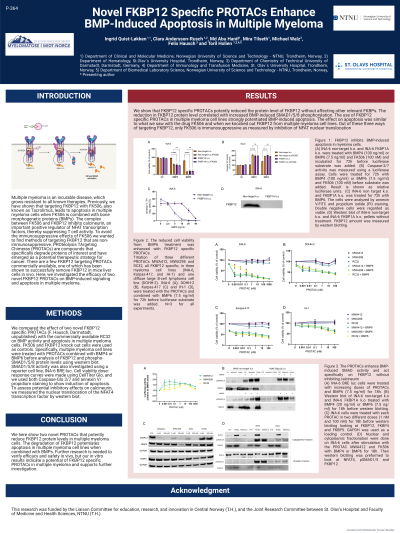Myeloma Genomics and cell signaling
Poster Session 3
P-364: Novel FKBP12 targeting PROTACs enhances BMP-induced apoptosis in multiple myeloma
Friday, September 29, 2023
1:15 PM - 2:15 PM EEST


Ingrid Quist-Løkken
Medical Research Student
Norwegian University of Science and Technology
Trondheim, Sor-Trondelag, Norway
Introduction: Multiple myeloma is an incurable disease, which grows resistant to all known therapies. Previously it has been shown that targeting FKBP12 with FK506, also known as Tacrolimus, leads to apoptosis in multiple myeloma cells when FK506 is combined with bone morphogenetic proteins (BMPs). To avoid the immunosuppressive effects of FK506 we wanted to find methods of targeting FKBP12 that are non-immunosuppressive. PROteolysis TArgeting Chimeras (PROTACs) are compounds that specifically degrade proteins of interest and have emerged as a potential therapeutic strategy for cancer. There are a few FKBP12 targeting PROTACs commercially available, one of which has been shown to successfully remove FKBP12 in mice liver cells in vivo. Here, we investigated the efficacy of two novel FKBP12 PROTACs on BMP-induced signaling and apoptosis in multiple myeloma.
Methods: We compared the effect of two novel FKBP12 specific PROTACs (unpublished) with the commercially available RC32 on BMP activity and apoptosis in multiple myeloma cells. FK506 and FKBP12 knock out cells were used as controls. Specifically, multiple myeloma cell lines were treated with PROTACs combined with BMP4 or BMP6 before analysis of FKBP12 and phospho-SMAD1/5/8 protein levels using western blot. Cell viability dose-response curves were made using CellTiter Glo and we used annexin V/propidium staining to show induction of apoptosis. SMAD1/5/8 activity was also investigated using a reporter cell line, INA-6 BRE-luc. To assess potential immunosuppressive effects, we measured the nuclear translocation of NFAT transcription factors by western blot.
Results: We show that FKBP12 specific PROTACs potently reduced the protein level of FKBP12 without affecting other relevant FKBPs. The reduction in FKBP12 protein level correlated with increased BMP-induced SMAD1/5/8 phosphorylation. The use of FKBP12 specific PROTACs in multiple myeloma cell lines strongly potentiated BMP-induced apoptosis. The effect on apoptosis was similar to what we saw with the drug FK506 and when we knocked out FKBP12 from multiple myeloma cell lines. Out of these three ways of targeting FKBP12, only FK506 is immunosuppressive as measured by inhibition of NFAT nuclear translocation.
Conclusions: We here show two novel PROTACs that potently reduce FKBP12 protein levels in multiple myeloma cells. The degradation of FKBP12 potentiates apoptosis in multiple myeloma cell lines when combined with BMPs. Further research is needed to verify efficacy and safety in vivo, but our in vitro results indicate a potential of FKBP12 specific PROTACs in multiple myeloma and supports further investigation.
Methods: We compared the effect of two novel FKBP12 specific PROTACs (unpublished) with the commercially available RC32 on BMP activity and apoptosis in multiple myeloma cells. FK506 and FKBP12 knock out cells were used as controls. Specifically, multiple myeloma cell lines were treated with PROTACs combined with BMP4 or BMP6 before analysis of FKBP12 and phospho-SMAD1/5/8 protein levels using western blot. Cell viability dose-response curves were made using CellTiter Glo and we used annexin V/propidium staining to show induction of apoptosis. SMAD1/5/8 activity was also investigated using a reporter cell line, INA-6 BRE-luc. To assess potential immunosuppressive effects, we measured the nuclear translocation of NFAT transcription factors by western blot.
Results: We show that FKBP12 specific PROTACs potently reduced the protein level of FKBP12 without affecting other relevant FKBPs. The reduction in FKBP12 protein level correlated with increased BMP-induced SMAD1/5/8 phosphorylation. The use of FKBP12 specific PROTACs in multiple myeloma cell lines strongly potentiated BMP-induced apoptosis. The effect on apoptosis was similar to what we saw with the drug FK506 and when we knocked out FKBP12 from multiple myeloma cell lines. Out of these three ways of targeting FKBP12, only FK506 is immunosuppressive as measured by inhibition of NFAT nuclear translocation.
Conclusions: We here show two novel PROTACs that potently reduce FKBP12 protein levels in multiple myeloma cells. The degradation of FKBP12 potentiates apoptosis in multiple myeloma cell lines when combined with BMPs. Further research is needed to verify efficacy and safety in vivo, but our in vitro results indicate a potential of FKBP12 specific PROTACs in multiple myeloma and supports further investigation.
